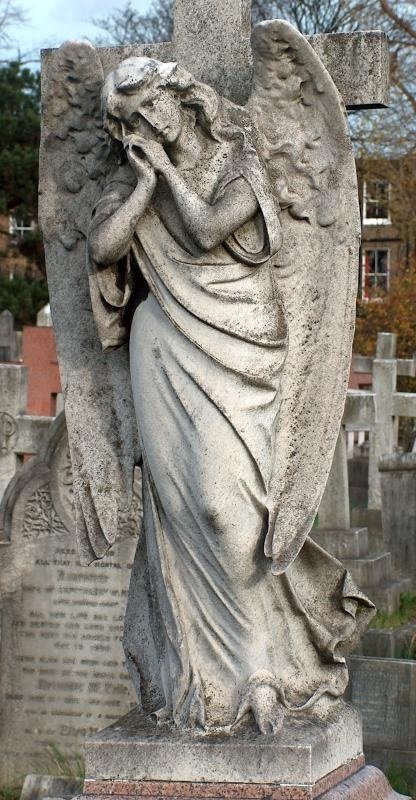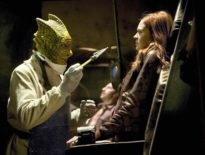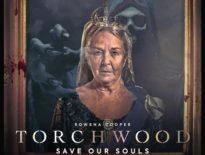No, I’m not trying to say that the Weeping Angels exist. Well, I am, sort of. There are weeping angels (with no initial capital letters) – but these are not to be confused with the Silent Assassins from Doctor Who. These lower case weeping angels are pieces of statuary which can be found in some churchyards in the UK; it was these which inspired Steven Moffat to wonder what would happen if they moved when you weren’t looking at them. When my kids were at primary school in the next village to ours, there was a churchyard next door to the school and it had a weeping angel in it, to the delight and terror of the tinies. It loomed over them during playtime. No doubt they hoped that it would jump on some of the fiercer teachers and eat them.
So. Real weeping angels are statues. They had their heyday during the Victorian and Edwardian period; after the death of Edward VII in 1910, they fell out of fashion, though you can still buy them from some suppliers of decorations for graves (and, of course, This Planet Earth will sell you some splendid Weeping Angel statues to put in your garden to scare the neighbours).
Some interesting bits of social history come into play here. Yes, they are interesting. Who dares to say otherwise?
It does seem that they were much more common in Anglican than in Catholic churchyards. We can speculate as to why. While there was a rediscovery in the Church of England of its Catholic heritage during the Victorian period, this wasn’t universal and many Anglicans just weren’t buying it: they maintained that Anglicans were Protestants, not reformed Catholics, and any manifestations of Catholicism were deemed deeply suspect. Needless to say, statues for memorials of the dead were expensive, so they were only available to the well-off: to the middle classes and the aristocracy. No weeping angels for paupers, O dear me no. Well-off Catholics tended to go for large stone crucifixes (note for pedants like me: a crucifix is a cross with a statue of Christ on it; a plain cross is just called a cross). These were considered a bit suspect by lots of Anglicans – not because they didn’t believe in the crucifixion but because they were just a bit too “Romish”. So, as they wanted nice statues but were a bit squeamish about crucifixes, they hit on a substitute: figures of angels who looked pretty sad. (Actually, some of them look more like they’ve got toothache than in mourning. Depends how good the sculptor was.)

And yes, these statues really were called weeping angels.
They were female, too. This is actually a bit odd. All the angels in the New Testament are male (or at least masculine); they’re given the pronoun “he” and the definite article for them is in its masculine form. “Angel” is related to the Greek verb “angello” – “I announce” or “I deliver a message”: they were considered to be messengers from God. But there didn’t seem to be any female ones. So why the change?
It’s not really clear. Victorian and Edwardian Anglicans knew their Bible, so they’d have noticed the change; presumably, it just didn’t bother them. It does seem possible, though, to link it to the attitudes at the time to the sexes. Angels were women, and women were angels. (Yes, I know the logic doesn’t work: if a = b, it doesn’t always follow that b = a. Just bear with me.)
In an age of stiff upper lips, repressed emotions and daft ideas about the unshakeable resolve and firm character (dammit sir!) of the Englishman, it would have been socially unacceptable to have a male statue expressing grief. Easier for men, who weren’t allowed to show “unmanly” emotions, to project them onto a female figure. Women were the nice ones, who were caring and nurturing; men pretended they hadn’t got any time for that sort of gammon because they had an Empire to run, damn me, cur: leave the feelings to the ladies, sir.
You can then link this to the Victorian idea, expressed by John Ruskin, of women as the angels of the house. (Don’t puke. It’s now my fault people used to think like that.) There’s a ghastly poem by some bloke called Coventry Patmore entitled (guess what?) The Angel in the House. It was published in parts between 1854 and 1862 and it’s interminable. I skimmed it when I was reading up for this article. Here is a typical extract (you may need your sick bag again):
Man must be pleased; but him to please
Is woman’s pleasure…
Stop heaving. Old man Patmore goes on for another hundred or so pages like this.

Anyway, the point I’m getting at is that, as well as being religious artefacts, weeping angels expressed a Victorian and Edwardian view of women. Not a view universally held, but a prevalent view nonetheless. The statues weren’t just of angels; they were an idealised depiction of the female, and of female virtue and compassion – or what was seen as such. Some of the less good weeping angels were particularly sentimental and woebegone and look like manifestations of Dickens’ soppier teenage heroines.
That said, some of them also seem to have been intended to be mildly titillating. Not exactly erotica, but not prudery either. Women in religious art had often been depicted as peculiarly sexless; even as recently as the 1990s, there was a controversy at Ely Cathedral over David Wynne’s newly commissioned statue of Mary, because her body looked more like a normal woman’s than people were used to. It’s all fairly innocuous, but the weeping angel statues gave the artist a chance to depict the female form more realistically; the drapery is pretty close to the body, revealing the shape rather than hiding it. No doubt some Victorians were outraged by this. Even so, the statues aren’t quite as prudish as some Victoriana.
And then weeping angels fell out of fashion after Edward VII’s death in 1910. Why?
I think it probably has something to do with the ‘angels are women, so women are angels’ idea. Female emancipation in the UK has its roots much further back than 1910; the novels of Anthony Trollope are full of stronger (and much more powerful) women characters than you’d find in Dickens, Trollope’s older contemporary. Even so, the sentimental view of women and of women’s roles became progressively more difficult to maintain. The Great War started only four years after Edward’s death; the military effort would not have been possible without women working in the munitions factories. At the end of the war, women had the vote (if they were over 30, admittedly). This isn’t a full survey of the rise of feminism, of course, and it’s so short, it’s fatuous, but as social attitudes changed, so did depictions of women in art. Weeping angels expressed and reflected an attitude to women that was no longer fashionable or even tenable. Stonemasons stopped making them.
A pity, really. But at least most of them have been left alone to guard our churchyards. It’s worth a ramble through your nearest churchyard to see if you can spot one.
But if you do, for pity’s sake, keep your eyes fixed on it. Walk backwards until it’s out of sight. Then it won’t get you.
At least, it won’t if you’re lucky.
Don’t blink.



